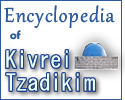Kivrei Tzadikim
(→Misrad Hadatot) |
(→Mikva) |
||
| Line 8: | Line 8: | ||
==Formalities== | ==Formalities== | ||
===Mikva=== | ===Mikva=== | ||
| + | It is important to purify oneself by immersing in a Mikva before visiting Kivrei Tzadikim, this is especially true if a person has experienced an emission. If a person can not immerse in a Mikva he should try to do a mikvah alternative such as Tisha Kavim or Nitalas Yadaim 40 times. Even if a person can not do the above he should still visit the Kevarim of true Tzadikim and rely on their power to cleanse him. This is only true in cases where the Tzadik is buried alone like the Rashbi, however in cases where a person has to first pass through a cemetery filled with less then holy bodies, one should avoid doing so without immersing in the Mikva. | ||
| + | |||
===Stepping on Graves=== | ===Stepping on Graves=== | ||
===Lighting Candles=== | ===Lighting Candles=== | ||
Revision as of 15:27, 21 October 2012
Kevarim of Tzadikim
Contents |
No Decaying
Tzadikim that were perfect in this world and were fully Shomer Habris, their bodies do not decay after they pass away. There are a few cases where Kevarim of Tzadikim were transferred in recent years and the workers saw the bodies fresh as they day they passed away.
Praying
Formalities
Mikva
It is important to purify oneself by immersing in a Mikva before visiting Kivrei Tzadikim, this is especially true if a person has experienced an emission. If a person can not immerse in a Mikva he should try to do a mikvah alternative such as Tisha Kavim or Nitalas Yadaim 40 times. Even if a person can not do the above he should still visit the Kevarim of true Tzadikim and rely on their power to cleanse him. This is only true in cases where the Tzadik is buried alone like the Rashbi, however in cases where a person has to first pass through a cemetery filled with less then holy bodies, one should avoid doing so without immersing in the Mikva.
Stepping on Graves
Lighting Candles
Burial Strategy
In Galil
During the early times of the Mishna and Talmud, many Tzadikim were brought up North to be buried. Although the trip sometimes took 2-3 days this was done to establish holiness into the Galil, something which the Yerushalaim area naturally had due to the Bais Hamikdash.
From Bavel
Many Tzadikim were brought up from Babylon to be buried in Eretz Yisroel, a trip that often took a few weeks. Sometimes these Tzadikim were brought up right after their passing. Other times they were temporarily buried locally and were transferred at a later point.
Far Out
Often Tzadikim were buried in the places where they used to study Torah and do Hisbodedute and meditations. These locations were often far out from civilization to avoid disturbances, explaining why some kevarim are in middle of nowhere. Additionally kivrei tzadikim were often planted in strategic locations across the country to provide protection and implant holiness on their surrounding areas. There are also instances where the area of the kever was inhabited 2000 years ago but has become abandoned throughout history.
Near Roads
Sometimes Tzadikim were buried near main roads so they could be visited by all the travelers passing by. Since many roads in Northern Israel have changed little since Roman times, as can be attested to by their many turns and curves, these Kevarim are found on the roadside till this day.
Moving Kevarim
In recent time a number of kevarim were moved from Diaspora to Eretz Yisroel including Rabbi Chaim Vital and the Chida.
Organizations
Kadmonanue
Vaad Hatzalos Kevrei Hakadmonim
Yisroel Meir Gabbai - Ohalei Tzadikim
Misrad Hadatot
Israeli Government Department of Religion

